Biden, Joe (1942-…), became president of the United States in 2021. In the 2020 presidential election, Democratic nominee Biden and his running mate, Senator Kamala Harris of California, defeated the Republican incumbents, President Donald J. Trump and Vice President Mike Pence. Biden had earlier served as vice president under President Barack Obama from 2009 to 2017 and had a long career in the U.S. Senate.
Prior to Biden’s ascent to the presidency, he had been a son of Scranton, Pennsylvania, and an ambitious young lawmaker in Delaware. He had worked to overcome a childhood stutter and faced embarrassment for a plagiarism incident during a national campaign. He became known for the devastating losses that struck his family, and for his tough-and-tender “Uncle Joe” persona waging national election battles with Obama.

In the 2020 campaign for his party’s nomination, Biden recovered after poor finishes in early nominating contests. In early spring, Biden built a sizable lead in pledged delegates over his closest rival, Senator Bernie Sanders of Vermont. Sanders, a leader of the party’s progressive wing, pledged his support for Biden’s candidacy in April, after the COVID-19 pandemic forced an end to traditional public campaign events.
COVID-19, a sometimes-fatal respiratory disease caused by a type of coronavirus, peaked in several northern U.S. cities in spring 2020 before later spiking in parts of the South and West. Many Americans were ordered to shelter at home, and state governors restricted social and business activities. Unemployment soared. Millions of Americans became infected with the virus, and thousands died. Trump sometimes downplayed the severity of the outbreak, and he cheered on protests against business restrictions. Some less partisan, or swing voters, began to wonder whether the president’s earlier presiding over a strong economy was now outweighed by his response to the COVID-19 crisis.
In late spring and summer, the deaths of African Americans at the hands of police officers sparked widespread protests. Trump largely ignored calls to address racial injustice. He portrayed himself as the law-and-order candidate who would protect Americans from riots, looting, and other lawless behavior that took place amid some protests. Biden criticized Trump’s use of federal agents to aggressively disperse and arrest protesters in Portland, Oregon, and Washington, D.C.
During the general election campaign, Biden told voters that the president had put Americans’ health at risk by failing to maintain a consistent message during the pandemic. He also chided the president for failing to encourage unity during periods of inflamed tensions between minority groups and police. Trump’s campaign worked to label the 77-year-old Biden as infirm, politically radical, and corrupt. On November 7, major news outlets called the election for Biden. President Trump did not concede the election, however. Trump and his allies contested the results through dozens of lawsuits and claimed without presenting evidence that Democrats had conducted widespread election fraud. On November 23, following a series of legal defeats, the Trump administration authorized the start of the formal transition to an administration under President-elect Biden. The Electoral College formally confirmed Biden’s victory on December 14. On Jan. 6, 2021, a violent mob of Trump’s supporters stormed the U.S. Capitol in a failed attempt to stop Congress’s affirmation of Biden’s victory. Biden and Harris took office on Jan. 20, 2021.
As president, Biden worked to pass laws that increased investments in infrastructure and clean-energy projects. He faced calls to control an influx of migrants at the nation’s southern border. Conflicts in Ukraine and the Gaza Strip tested Biden’s influence in both domestic politics and international diplomacy. By mid-2024, Biden and Trump had become the presumptive (likely) nominees of their parties for that year’s presidential election. However, Biden ended his presidential campaign in July while facing concerns about his health and age.
Early life
Family background.
Joseph Robinette Biden, Jr., was born in Scranton, Pennsylvania, on Nov. 20, 1942. He was the first of four children, followed by Valerie (1945-…), a political strategist; Jim (1949-…), an entrepreneur; and Frank (1953-…), a real estate developer. Their parents were Joseph Robinette Biden, Sr. (1915-2002) and Catherine Eugenia Finnegan (called Jean) (1917-2010).
Biden’s roots in Scranton went back generations. A maternal great-great-grandfather had been a state senator, and a great-grandfather had been an engineer who developed many of the city’s streets. The family was Irish on his mother’s side, and mostly English on his father’s. Biden’s English ancestors came to America in the early 1800’s, settling in Maryland. Biden’s mother’s ancestors came from Ireland during the potato famine of the mid-1800’s. Biden gained insight into his heritage during a 2016 state visit to Ireland while serving as vice president.
Boyhood.
Biden often referred fondly to his childhood in Scranton. He recalled playing pick-up baseball games, seeing Western movies at the cinema, visiting with grandparents, and attending Roman Catholic Mass on Sundays.


Joe was popular among his peers. Friends recalled that Joe would never turn down a dare. But he struggled with a stuttering impediment. Classmates sometimes mocked him or called him cruel names. Joe’s mother would comfort him. But she urged him to stand up to bullies, and Joe sometimes got into fistfights. A favorite uncle had also stuttered, and Joe had seen him lose confidence. Joe aimed to become a stronger speaker. He memorized passages of poetry and recited them in the mirror. He would later often say that his difficulties helped him develop empathy for other people who struggle.
Biden’s parents struggled financially through much of his childhood. The business career of Joe Biden, Sr., had had a promising start. But a series of setbacks left the elder Biden and his family trying to make ends meet. The family lived with Joe’s maternal grandparents, the Finnegans, in Scranton’s predominantly Irish Catholic Green Ridge neighborhood. By 1950, job opportunities in the area had become scarce following the closure of local coal mines and textile mills. Biden’s father kept looking for work.
Years later, on the campaign trail, Joe would frequently mention his father’s resiliency. “My dad always said, ‘Champ, the measure of a man is not how often he is knocked down, but how quickly he gets up’,” Biden said.
Delaware days.
In 1953, the family moved from Scranton to a two-bedroom apartment in Claymont, Delaware, just northeast of Wilmington. Biden’s father had found work cleaning boilers there, and he later managed a used-car dealership. The family often drove back to Scranton to see family on weekends and holidays.
The Bidens’ home stood across the street from Archmere Academy, an exclusive Catholic preparatory school. The family couldn’t afford to send Joe there. Joe began painting fences, weeding gardens, and taking on other odd jobs around the school to help pay the tuition. The Bidens later moved to a single-family home in Wilmington.
Biden’s school friends recalled that he often started conversations about civil rights and environmental issues. He grew taller and joined the baseball and football teams. He was a standout in football as a halfback and wide receiver, leading his undefeated team in scoring during his senior season. Described by classmates as bright and talkative, Biden was voted class president his junior and senior years.
College and law school.
After graduating from prep school, Biden attended the University of Delaware. He joined the freshman football team, but his parents, upset with Joe’s poor academic marks, made him quit the sport. By his own admission, Joe was more focused on socializing, playing pranks, and having lively debates in the dormitories than in attending class.
Biden met Neilia Hunter, an education student at Syracuse University, while on a spring-break trip during his junior year. The pair became a couple, and Joe began to concentrate harder on his studies. In 1965, he earned a bachelor’s degree with a double major in history and political science. He then joined Neilia in upstate New York, where he attended the College of Law at Syracuse University. Biden graduated in 1968. He again had been an indifferent student, however, graduating 76th of the 85 students in his law class.
Early career
After law school, Biden clerked for a Wilmington law firm. He passed the Delaware bar exam in 1969. He began working part-time as a public defender, taking on cases for poor clients. He also worked for another law firm before starting his own practice. Biden took little joy from practicing law. He saw the nation embroiled in conflict over civil rights and the Vietnam War, and he sought a future in politics.
Biden’s family
Biden and Neilia Hunter (1942-1972) married in 1966, after Biden had become a law student at Syracuse. The couple had three children: Joseph III (called Beau) (1969-2015); Robert (called Hunter) (1970-…); and Naomi (called Amy) (1971-1972).
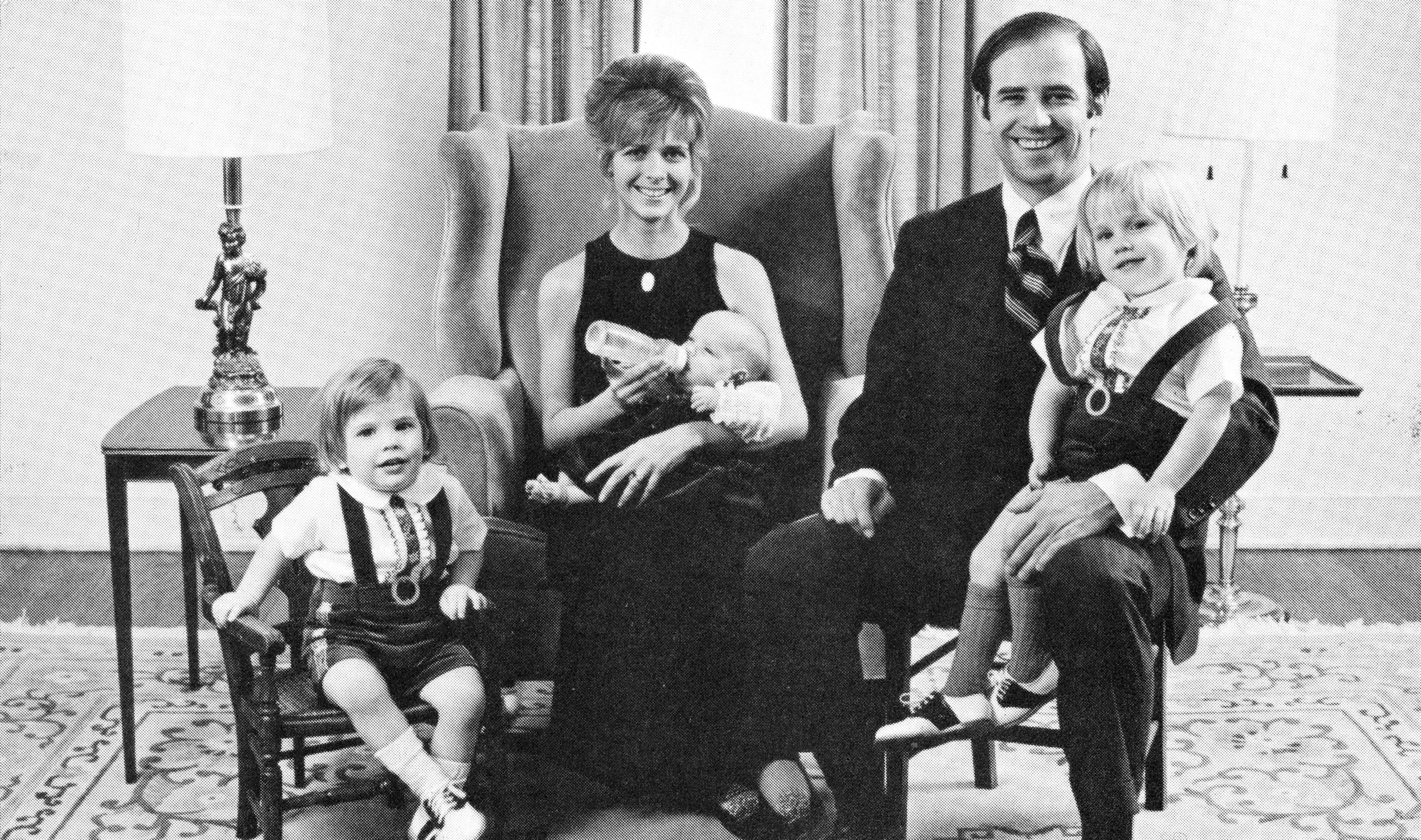
In December 1972, soon after Biden was first elected to the Senate, his wife and daughter were killed in an automobile accident while on a shopping excursion for a Christmas tree. Biden’s sons were badly injured in the accident but survived.
Biden remarried in 1977. His wife, Jill Jacobs (1951-…), was an educator who became a professor of English. The couple have a daughter, Ashley (1981-…).
In 2015, Biden’s son Beau died at the age of 46. Beau Biden, who served two terms as Delaware attorney general, had been diagnosed with brain cancer.
Entry into politics
County councilman.
Biden joined the Democratic Party while working as a young lawyer. In 1970, he won election to the New Castle County Council. He served on the council from 1970 to 1972.
United States senator.
Local Democrats saw promise in Biden. In 1972, they encouraged him to mount a long-shot campaign against a popular Republican incumbent of the U.S. Senate. The 29-year-old Biden faced J. Caleb Boggs, a two-term senator and former Delaware governor, in the general election. Biden’s sister served as campaign manager, and his father helped him conduct a door-to-door campaign. In November, Biden won an upset victory with a margin of only a few thousand votes. He turned 30—the minimum age for a senator—about two weeks after the election.
Delaware commute.
Biden’s Senate career began in January 1973, weeks after the deaths of his wife and daughter. His sons remained hospitalized at the time. Biden decided that he would continue to live in Wilmington to care for his sons and travel each day to Washington, D.C., for his work in the Senate. He was reelected in 1978 and every six years through 2008. For this train commute, which continued throughout his 36-year Senate career, Biden gained the nickname “Amtrak Joe.”
Embarrassing setback.
In June 1987, Biden began a campaign for the 1988 Democratic presidential nomination. Political observers considered him one of the party’s stronger candidates. In September, however, news reports showed that, in a speech a month earlier in Iowa, he had plagiarized (quoted without attribution) the words of British politician Neil Kinnock. Biden had quoted Kinnock in earlier versions of the speech but omitted the attribution at the Iowa event. News stories also surfaced with accounts of Biden misstating his academic record. Biden soon ended his once-promising campaign. The incident humbled Biden and damaged his national reputation. But he remained committed to his Senate work and maintained his political popularity in his home state. 
Judiciary Committee
Biden chaired the powerful Judiciary Committee from 1987 to 1995. In his first year as chairman, he won attention for his tough questioning of conservative Supreme Court nominee Robert Bork. The Senate later voted against Bork’s nomination. In 1988, Biden suffered two brain aneurysms—that is, the weakening and swelling of arteries in the brain. He missed seven months in the Senate while recovering.
Biden had long courted supporters in poor minority communities, but he also sought the support of law enforcement personnel. In the late 1980’s and early 1990’s, public opinion polls showed that crime was a top concern for voters. In 1994, Biden guided the Senate passage of the Violent Crime Control and Law Enforcement Act, a major anticrime bill. The law included funding to hire 100,000 police officers, build new prisons, and conduct crime prevention programs in communities nationwide. 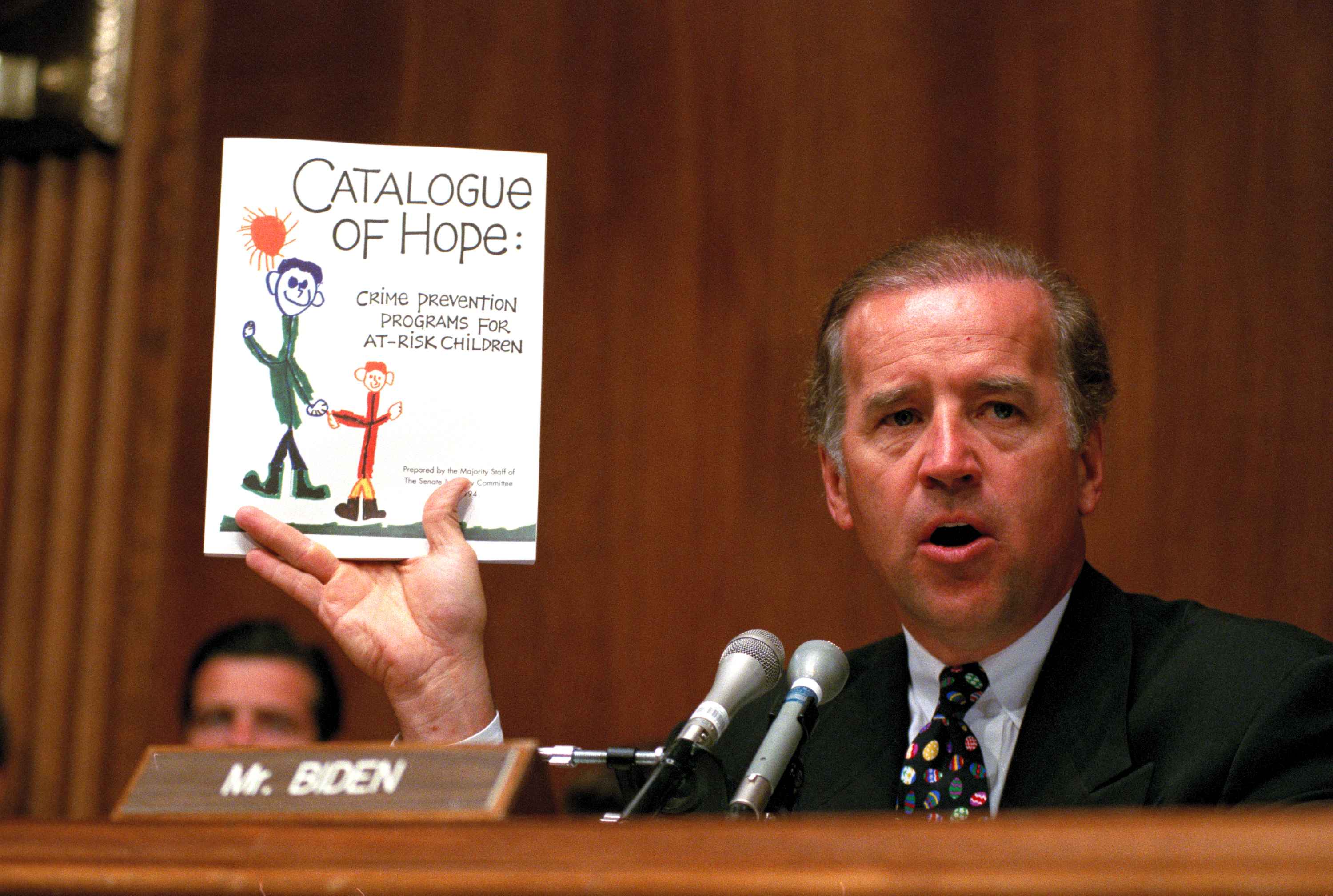
Biden later expressed regret that certain parts of the crime bill—particularly its “three-strikes” provision—came to contribute to devastating outcomes in minority communities. The provision called for mandatory minimum prison sentences for persons convicted of three felonies. It stripped judges of options to issue more lenient punishments. In the 15 years following the bill’s passage, violent crime rates decreased—due to a variety of factors—but the number of Americans in prisons doubled. Biden continued to defend some of the act’s provisions, including its restrictions on automatic-weapon purchases and its measures encouraging states to treat, rather than imprison, nonviolent drug-law offenders.
Legislative accomplishments.
Biden was chairman of the Senate Foreign Relations Committee from 2001 to 2003 and from 2007 to 2009. As a regular member of the committee, he introduced antiterrorism legislation and worked with conservative Republicans to pass arms-control agreements. In his career, Biden also introduced the first Senate bill to address climate change and was a primary sponsor of the Violence Against Women Act. Because he was more a dealmaker than an ideologue, Biden’s votes over the years on such issues as banking deregulation and welfare reform drew the ire of both liberal and conservative observers. Befitting his commuting nickname, Biden was also a strong supporter of public transportation projects. In 2007, prior to embarking upon a presidential campaign, Biden wrote a memoir, Promises to Keep: On Life and Politics.
The 2008 election.
In January 2007, Biden began a campaign for the 2008 Democratic nomination for president. He dropped out of the race in January 2008, however, after a poor showing in the Iowa Democratic caucuses. Senator Barack Obama eventually outlasted Senator and former First Lady Hillary Rodham Clinton in a bruising and expensive contest for the nomination.
Obama placed Biden on his short list of vice-presidential options from the start. Biden initially declined to be considered for the position before reconsidering. Obama found the nearly two-decades-older Biden to be a voice of experience—particularly in foreign policy—with a compelling personal story. Biden proved a feisty campaigner who helped communicate the ticket’s message to working-class white voters.
Vice president
In August 2008, at the Democratic National Convention in Denver, delegates nominated Biden to be Obama’s running mate. Obama and Biden were to face Republican opponents Senator John McCain of Arizona and Alaska Governor Sarah Palin. After Biden sparred with Palin in an October debate, polls showed that voters valued the experience he could bring to the vice presidency. In November, Obama and Biden defeated McCain and Palin by a comfortable margin. Biden also stood for reelection as senator and won, but he resigned the seat before taking office as vice president.

Obama and Biden were renominated in 2012 at their party’s convention in Charlotte, North Carolina. They faced former Massachusetts Governor Mitt Romney and U.S. Representative Paul Ryan of Wisconsin in the general election. Biden and Ryan held an animated vice presidential debate. Biden made headlines after calling his opponent’s assertions “a bunch of malarkey.” Biden’s performance helped Obama and Biden in the polls, and they went on to defeat Romney and Ryan in November.
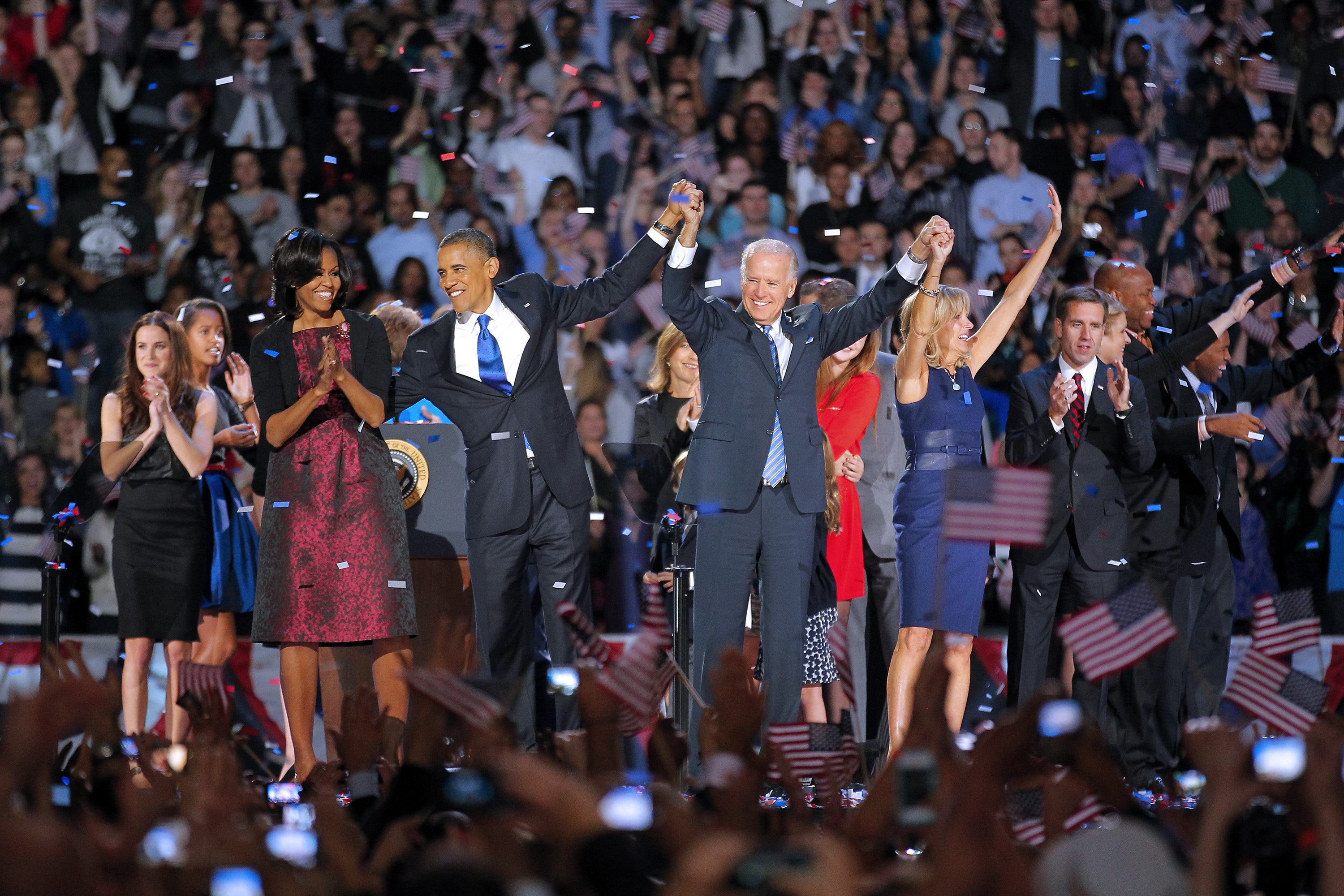
As vice president, Biden met with leaders around the world. He helped implement a $787-billion economic stimulus bill meant to shore up a U.S. economy struggling through a global economic slowdown. He spoke in favor of legal same-sex marriage, and he worked to bring an end to the Iraq War (2003-2011). Biden became known for his heartfelt speeches about coping with grief. His book Promise Me, Dad: A Year of Hope, Hardship, and Purpose (2017) recounted his experience of losing his son Beau to cancer. In 2016, Obama named Biden to lead the White House Cancer Moonshot. The program aimed to coordinate research activities and streamline the development of new cancer treatments.
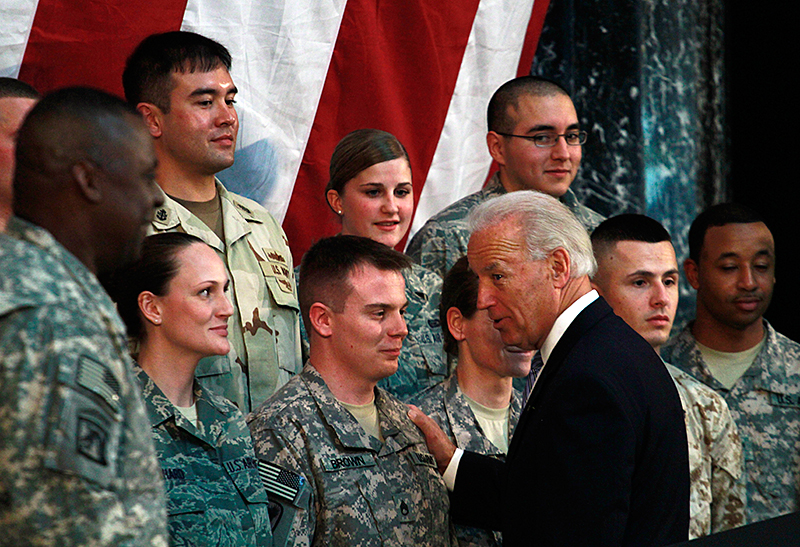
In 2015, Biden explored mounting a campaign for the 2016 presidential nomination. Polls showed him in a tight contest with Hillary Clinton. Grieving the death of his son, however, he decided that the time was not right for campaigning. Clinton lined up support from Democratic officials, and Biden prepared for a career after politics.
A brief-but-busy retirement
Biden left the office of vice president in January 2017. In February, Joe and Jill Biden announced the creation of the Biden Foundation, which focused on a range of issues, including foreign policy, helping military families, and combating violence against women. They also formed the Biden Cancer Initiative, a nonprofit foundation building on the Obama administration’s efforts to fight the disease while Biden served as vice president.
Biden was named to lead a University of Pennsylvania academic center focused on foreign policy and national security. He also led a University of Delaware program dedicated to domestic policy. The National Constitution Center in Philadelphia, Pennsylvania, named Biden its chairman. Biden recorded an audiobook, Conversations With Joe (2018), in which he discussed his family and career.
Trump’s narrow upset, in 2016, of the favored Clinton threatened to undo many of the accomplishments of the Obama presidency. After Trump became president, Biden bristled at many of his statements and actions. He resolved to try to deny Trump a second term.
2020 presidential campaign
The race for the nomination.
In April 2019, Biden announced that he would seek the Democratic Party’s 2020 nomination for president of the United States. In his announcement, Biden warned of the dangers of white nationalism and declared that Trump posed a threat to the nation’s values.
Rivalry and impeachment.
Well before the 2020 campaign began, Trump’s advisers had identified Biden as the Republican’s likeliest opponent and worked to discredit him. Reports claimed that in July 2019, Trump, presenting no evidence, repeatedly asked Ukraine President Volodymyr Zelensky to launch an investigation into what he called possible corruption involving Biden and his son Hunter. Hunter Biden had served on the board of directors of the Ukrainian energy company Burisma, and a conspiracy theory about the Bidens had developed among some right-wing commentators.
In September 2019, the House of Representatives began an impeachment inquiry into Trump’s actions regarding Ukraine. Reports alleged that Trump had instructed aides to withhold the transfer to Ukraine of about $400 million in military aid that Congress had approved. The report charged that Trump used the funds as leverage while insisting that Ukraine investigate the Bidens. Trump acknowledged that he had invited Ukraine to investigate the Bidens but insisted that his actions were not illegal.
In December, the House of Representatives approved two articles of impeachment: (1) abuse of power, for urging a foreign power to investigate a domestic political rival; and (2) obstruction of Congress, for impeding investigators. Trump’s impeachment trial in the Senate began in January 2020. In February, the Senate, voting almost entirely along party lines, acquitted President Trump of the charges.
Nomination contests.
At the start of the nomination campaign, Biden consistently appeared at or near the top of opinion polls. Democratic candidates gathered for a series of debates beginning in June 2019. Biden’s debate opponents frequently focused their attacks on the front-runner. Competitors for the nomination included Senators Elizabeth Warren of Massachusetts, Harris of California, Cory Booker of New Jersey, Amy Klobuchar of Minnesota, and Sanders of Vermont; U.S. Representative Tulsi Gabbard of Hawaii; Pete Buttigieg, mayor of South Bend, Indiana; and former New York City Mayor Michael Bloomberg.
In February 2020, Biden finished fourth in Iowa and fifth in New Hampshire, the first two nominating contests of the year. Sanders’s campaign appeared to have the most momentum of any of the candidates. But Biden drew on the support of establishment Democratic officials, many of whom he had worked with for decades. His longtime contacts in African American communities helped bring out support in South Carolina and other states holding primaries. Later in the month, Biden had a bounce-back win in South Carolina. Biden pulled ahead in the delegate count after voting on March 3—so-called Super Tuesday—but the race remained close. He extended his lead later in March. About that time, the COVID-19 pandemic curtailed traditional campaigning. Sanders ended his campaign in April, and Biden became the party’s presumptive nominee. In June, Biden won enough delegates to officially secure the nomination.
Seasons of discord.
COVID-19 caused major disruptions to life in the United States beginning in early 2020. State and local officials implemented business and social restrictions to safeguard public health. Congress passed, and Trump signed, measures to provide relief to unemployed workers and vulnerable businesses. Restrictions were lifted for some areas later in the spring, but deadly outbreaks continued to occur.
In the late spring and summer of 2020, the quiet of COVID-19 lockdowns gave way to loud and sustained protests against racial injustice. Demonstrations began in May, following the brutal video-documented death of an African American man, George Floyd, while he was in the custody of Minneapolis police. The shooting of Jacob Blake of Kenosha, Wisconsin, by police led to further protests in August.
Convention.
In mid-August, prior to the Democratic National Convention, Biden named California Senator Kamala Harris to be his running mate. The convention took place in Milwaukee from August 17 to 20. Because of the ongoing pandemic, convention speeches occurred “virtually”—that is, via video transmission—without in-person attendees. Speakers included Michelle Obama, Bernie Sanders, and Hillary Clinton; and former Presidents Jimmy Carter, Bill Clinton, and Barack Obama. Republicans who attested to Biden’s character included John Kasich, former governor of Ohio; former Secretary of State Colin Powell; and Cindy McCain, wife of the late Senator John McCain.
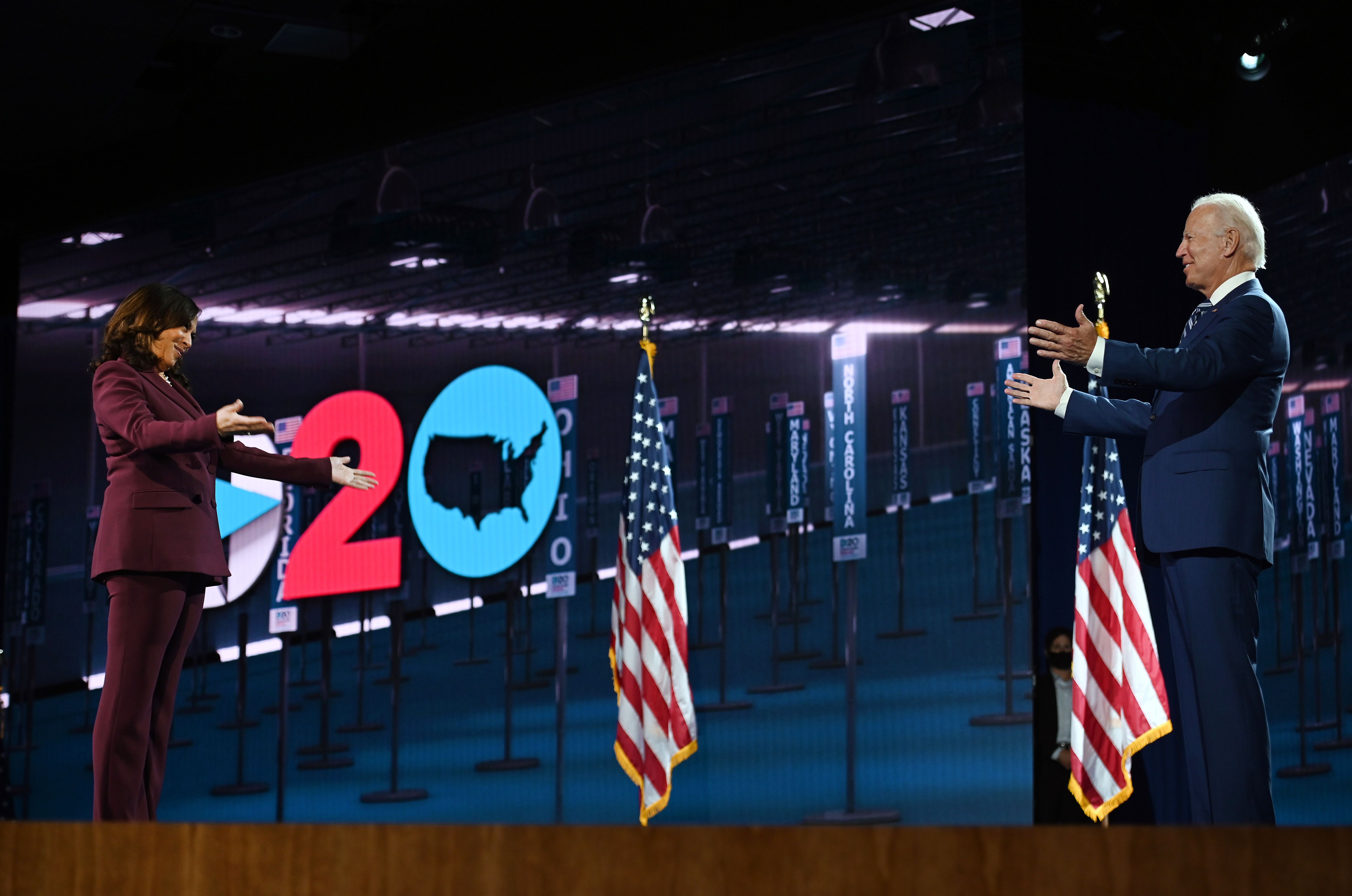
Biden accepted the nomination on August 20, when he asked voters, “with love and hope and light, [to] join in the battle for the soul of our nation.” He urged Americans to act with compassion and decency, and he spoke of the urgency to protect democratic institutions against what he called Trump’s abuses. Biden had worked with Sanders to craft proposals to appeal to the progressive wing of the party. The party’s platform included helping Americans with child-care and elder-care expenses; expanding access to affordable housing; and investing in education, especially in poor communities. Biden also proposed to strengthen the Social Security program, enact reforms in the criminal justice system, and take steps toward universal health care coverage.
General election campaign.
The race between Biden and Trump officially began in late August, after Trump and Pence were renominated to be the candidates of the Republican Party. In campaign ads and speeches, Biden and Trump clashed fiercely over the Trump administration’s response to the COVID-19 pandemic; claims of systemic racism and the use of force by police; and international alliances and trade agreements. Political arguments also became personal. Biden called Trump the most divisive president in the nation’s history. Trump said that Biden was not fit for the challenges of the position.
For all the differences in their political philosophies and the circumstances of their upbringing, the candidates shared some commonalities. Both had gained recognition as teenage athletes and class leaders. Both were teetotalers (nondrinkers) who had seen family members succumb to alcohol addiction. And both candidates, born in the 1940’s, would be the oldest ever to win election as president.
In late September, Biden and Trump participated in their first presidential debate. Days later, on October 2, Trump announced that he had tested positive for COVID-19. Trump’s wife Melania, son Barron, and a number of White House aides also tested positive for the virus. President Trump received treatment at Walter Reed National Military Medical Center for about three days before returning to the White House. Organizers proposed that a second debate, scheduled for October 15, be held virtually because of concerns about Trump’s diagnosis and possible contagiousness. Trump declined to participate in a virtual debate, however, and the two candidates appeared separately in televised “town hall”-style forums. A final in-person debate took place on October 22.
Election day was November 3. That evening, election tallies looked favorable for the president. Many states had urged voting by mail as a precaution during the pandemic, however, and millions of voters had returned mail-in ballots that remained to be counted. In the following days, Biden pulled ahead of Trump in several key states.
On November 7, major news outlets called the election for Biden, though election results had yet to be certified. Trump refused to concede, however, and challenged several state results via lawsuit. He and his campaign alleged fraud in the election but failed to prove such charges in court to the judges’ satisfaction. On November 23, following a string of legal defeats, the Trump administration authorized the start of the formal transition to a Biden administration. In the national popular vote, Biden held a lead of about 7 million votes over Trump. Both Biden—with about 81 million votes—and Trump—with 74 million—received more votes for president than any candidate in U.S. history. The Electoral College confirmed Biden’s victory on December 14. Biden received 306 electoral votes, and Trump received 232.
Trump, however, continued to claim that there had been widespread fraud in the election. On Jan. 6, 2021, Trump repeated the unsubstantiated claims to a boisterous crowd of supporters attending a rally near the White House. Hours later, the pro-Trump protesters stormed the U.S. Capitol, where Congress had assembled to certify the Electoral College result. Many police officers suffered injuries. Police shot and killed one rioter, and dozens of others were arrested. The mob also looted offices and caused other damage. Congress reconvened later in the evening, after law enforcement personnel secured the Capitol. At about 3:30 a.m. on January 7, Vice President Pence formally confirmed Biden’s victory in the election. On January 13, the House impeached Trump a second time. Representatives voted to approve a single article of impeachment—incitement of insurrection—for “inciting violence against the government of the United States.”
Trump’s second impeachment trial took place in the Senate in February. Seven Republican senators joined Democrats in voting to convict the former president on the charge of incitement of insurrection. The 57-to-43 vote fell 10 votes short, however, of the 67 votes required for a conviction.
Biden’s presidential administration
On Jan. 20, 2021, Biden was sworn in as president by Chief Justice John Roberts of the Supreme Court of the United States. In his inaugural address, Biden spoke of the recent violence at the Capitol and the fragility of democracy. He led a silent prayer to commemorate the hundreds of thousands of American lives lost to the pandemic. And he addressed the many challenges that lay ahead for the nation.
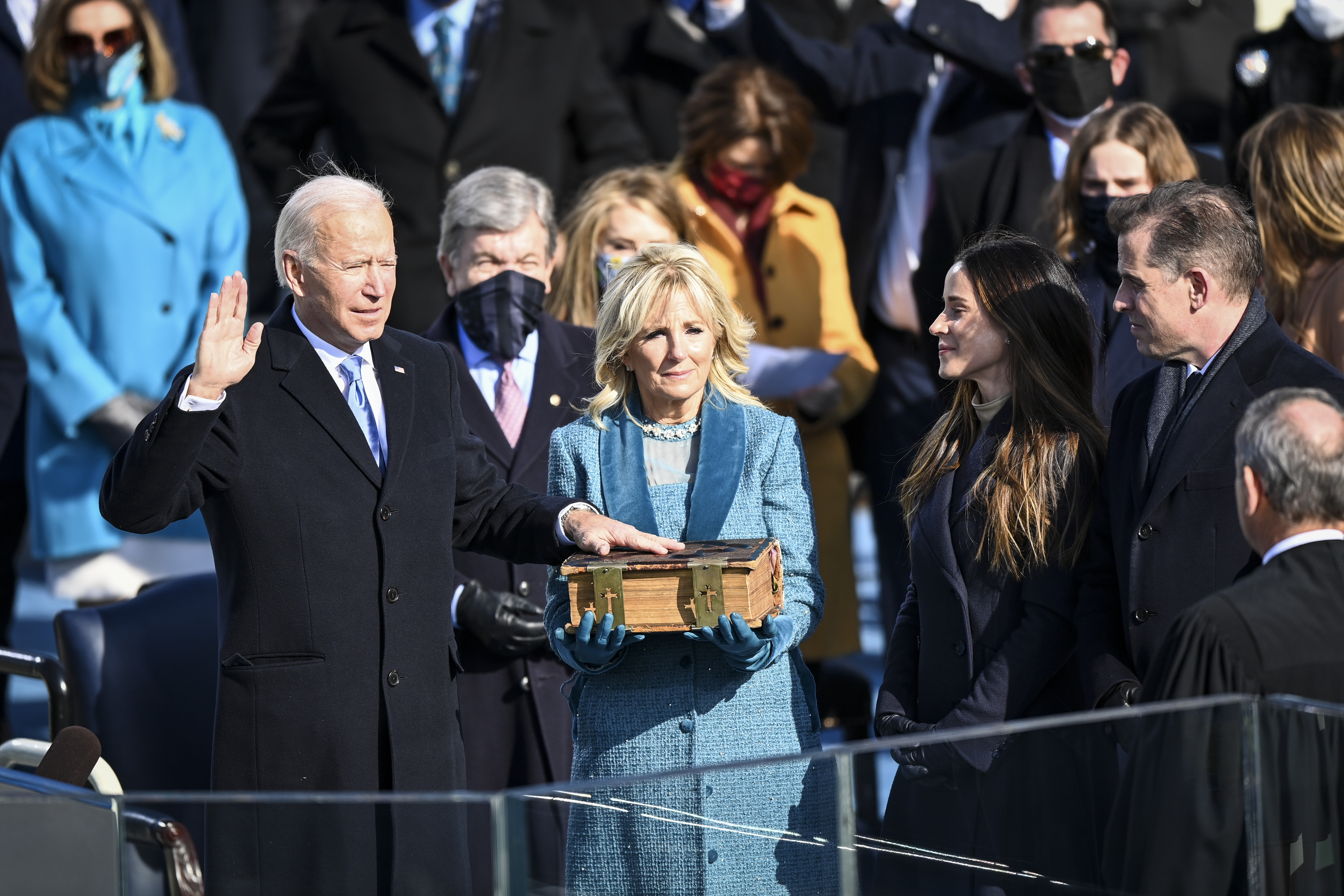
“Few periods in our nation’s history have been more challenging or difficult than the one we’re in now,” Biden said. “A once-in-a-century virus silently stalks the country. It’s taken as many lives in one year as America lost in all of World War II. Millions of jobs have been lost. Hundreds of thousands of businesses closed. A cry for racial justice some 400 years in the making moves us. The dream of justice for all will be deferred no longer. A cry for survival comes from the planet itself. A cry that can’t be any more desperate or any more clear. And now, a rise in political extremism, white supremacy, domestic terrorism that we must confront and we will defeat. To overcome these challenges—to restore the soul and to secure the future of America—requires more than words. It requires that most elusive of things in a democracy: Unity.”
A number of Biden’s nominees for Cabinet positions were confirmed by the Senate in the early days and weeks of his administration. Prominent appointees included Antony Blinken as secretary of state, economist Janet Yellen as secretary of the treasury, federal appeals court judge Merrick Garland as attorney general, former mayor Pete Buttigieg as secretary of transportation, and retired Army General Lloyd J. Austin III as secretary of defense. Linda Thomas-Greenfield was confirmed as U.S. ambassador to the United Nations, and Avril Haines was confirmed to lead the Office of the Director of National Intelligence. The office oversees a number of U.S. intelligence agencies.
On March 11, Biden signed into law a $1.9-trillion coronavirus relief bill. The plan, which passed the House and Senate with no support from opposition Republicans, extended unemployment benefits, provided funds for schools and state and local governments, and increased funding for coronavirus testing and vaccine distribution. The plan also expanded child tax credits and health insurance subsidies and included stimulus payments for millions of low- and middle-income Americans. Vaccination rates rose sharply later in the spring, and infection and death rates declined throughout the country. During the summer and through the end of the year, however, the spread of highly contagious COVID-19 variants led to another increase in infections. Most hospitalizations and deaths occurred among unvaccinated people.
In June, Biden took the first international trip of his presidency. In Cornwall, in the United Kingdom, he attended a meeting of the G-7 (Group of Seven) countries. The G-7 countries are leading industrialized countries that have democratic governments: Canada, France, Germany, Italy, Japan, the United Kingdom, and the United States. Biden then attended North Atlantic Treaty Organization (NATO) and European Union-United States summits, both in Brussels, Belgium. He later joined Russian President Vladimir Putin for talks in Geneva, Switzerland. Biden and Putin discussed matters related to human rights, events in Ukraine and Belarus, and cybersecurity. Weeks before the meeting, the administration had implemented additional sanctions against the Russian government for Russia’s interference in U.S. elections, among other provocative actions.
In April, Biden had announced that the United States would withdraw the last U.S. troops from Afghanistan by September. United States and allied forces had been stationed there since the start of the Afghanistan War in 2001. Taliban forces retook several major cities in the months after Biden’s announcement. United States and allied personnel worked to evacuate 124,000 people from Afghanistan, including civilians from the United States and other NATO countries, as well as allied Afghans and their families. The administration’s withdrawal preparations drew widespread criticism in August 2021, after broadcasts showed desperate Afghans rushing to overcrowded evacuation planes. Later in the month, a terrorist bombing at the Kabul airport killed about 170 Afghans and 13 U.S. troops. The last U.S. soldiers left Afghanistan on August 30.
In September, the United States, the United Kingdom, and Australia signed a military pact known by the acronym AUKUS. The pact, which provides Australia with the capability to build nuclear-powered submarines, was intended to counter potential aggression from China in the Pacific Islands region.
In November, the House passed, and Biden signed, a $1-trillion infrastructure bill. The measure, passed by the Senate in August, was a key piece of Biden’s domestic agenda. It provided funding to upgrade the electricity grid, expand high-speed internet access, and repair aging roads, bridges, and rail lines.
Developments in Eastern Europe drew the world’s attention in February 2022 as Russia massed more than 150,000 troops along the borders of Ukraine. Russia’s president, Vladimir Putin, demanded that the members of NATO reduce their military presence in Eastern Europe and guarantee that Ukraine would never be admitted to NATO. Biden refused to consider potential limits on NATO membership but offered to discuss Russia’s concerns regarding weapons and military forces based in Europe. The Biden administration sent 3,000 U.S. troops to support forces in Poland and Romania, two NATO countries that border western Ukraine.
On February 24, on Putin’s orders, Russian forces invaded Ukraine. Biden addressed the American public later that day. He said, “Putin chose this war, and now he and his country will bear the consequences.” Biden announced economic sanctions against Russia and Putin. He warned Russia that U.S. and allied military forces would forcefully respond to attacks on any NATO country. The Biden administration also sent thousands of additional U.S. soldiers to bases in Europe. In addition, in the following months, the United States sent large amounts of economic, humanitarian, and military aid to Ukraine.
Also in February 2022, Biden nominated Judge Ketanji Brown Jackson to the Supreme Court of the United States. Jackson was serving on the U.S. Court of Appeals at the time. A month earlier, Associate Justice Stephen Breyer had announced that he would retire from the Supreme Court after the court’s summer recess that year and after the confirmation of his successor. The Senate confirmed Jackson’s nomination in April, and on June 30 she became the first African American woman to serve on the court.
Biden’s administration faced a number of challenges in the months leading up to the 2022 congressional elections. Public opinion polls showed that the ongoing COVID-19 pandemic, concerns about crime and the economy, and the war in Ukraine contributed to a sense of unease among voters. Rates of violent crime had been rising since 2020. A series of mass shootings—including mass murders in Buffalo, New York, and Uvalde, Texas—brought renewed attention to political divisions on gun control measures. Job growth remained strong, and unemployment had reached historically low levels. But homelessness, increasing since the mid-2010’s, had become more visible in communities around the country. Economists began to worry about rapid increases in food, energy, and housing prices brought on by rising costs for raw materials, labor, and other factors. Disruptions in the global supply chain also contributed to higher prices for automobiles and other goods. A supply chain is a network in which companies supply raw materials or parts to other companies to create finished products.
In June 2022, in the case of Dobbs v. Jackson Women’s Health Organization, the Supreme Court overruled the 1973 decision Roe v. Wade by deciding that there was no constitutional right to abortion. A number of Republican-controlled states moved immediately to ban abortion in nearly every circumstance. Other states took steps to protect women’s access to the procedure. Biden criticized the court’s decision and said that his administration would defend the right of any American to travel between states for any reason, including medical purposes.
In August 2022, Congress passed, and Biden signed, the Inflation Reduction Act. The law provided funding to reduce health care costs, invest in clean energy projects, collect taxes from high earners and large corporations, and reduce the federal budget deficit. The law gave Medicare the ability to negotiate prescription drug costs, levied a 15-percent minimum tax on corporate profits, and funded numerous investments in clean energy to reduce carbon emissions and energy costs. The legislation passed both the House and the Senate with no support from Republicans. In the Senate, Vice President Harris cast the deciding vote to pass the bill by a margin of 51-50.
Continued high inflation and long-term political trends led many observers to predict a “red wave”—that is, a Republican takeover of both houses of Congress—in the November midterm elections. Republicans narrowly captured the House of Representatives, but Democrats fared better than expected in many races nationwide. Biden celebrated as Democrats maintained a majority in the Senate.
In late 2022, Congress passed, and Biden signed, the Respect for Marriage Act. The new law, which served to repeal the Defense of Marriage Act of 1996, guaranteed federal recognition of all same-sex marriages valid under state law. It required all states to recognize same-sex marriages—as well as interracial marriages—performed in other states. The Supreme Court’s 2015 decision in Obergefell v. Hodges had already recognized that the fundamental right to marry was guaranteed to same-sex couples. But the Respect for Marriage Act was meant to ensure that the right to marry would remain federal law regardless of future court decisions. The Respect for Marriage Act also included provisions to satisfy conservative concerns about religious freedom. The law ensured that nonprofit religious organizations would not be obligated to participate in the celebration of same-sex marriages.
In February 2023, Biden made an unannounced visit to Kyiv, Ukraine’s capital, to mark the first anniversary of the Russian invasion of Ukraine. “One year later, Kyiv stands,” Biden said. “And Ukraine stands. Democracy stands. The Americans stand with you, and the world stands with you.”
Biden then traveled to Warsaw, Poland, where he met with representatives of the eastern European countries that belong to NATO. He called for unity in efforts to protect Ukraine and other democracies from Russian aggression.
In April, Biden visited Northern Ireland—a division of the United Kingdom—to commemorate the 25th anniversary of the Good Friday Agreement. This political settlement, signed in 1998, helped resolve conflicts between warring factions in Northern Ireland. Biden then traveled to the Republic of Ireland, where he visited sites associated with his ancestors. In Dublin, he addressed a joint session of the Irish Parliament.
On April 25, 2023, Biden released a short film announcing that he would campaign for reelection in 2024. At a public speech later that day, he declared, “Let’s finish the job.”
Immigration became one of Biden’s main practical and political concerns in 2023. Tens of thousands of migrants were arriving at the U.S. southern border every month. Many of them were asylum seekers from such countries as Venezuela, Haiti, and Nicaragua. Republican governors in Texas and Florida sought to highlight the immigration crisis by busing migrants to such Democratic-led cities as Chicago, Los Angeles, and New York. Mayors of the cities asked for federal funding to help handle the migrant influx. Biden called on Congress to craft legislation addressing the crisis. In September, the Biden administration granted temporary legal status to hundreds of thousands of Venezuelan migrants, allowing them to obtain work permits.
In mid-October 2023, Biden visited Israel at a time of extreme tension in the Middle East. On October 7, the Palestinian political and militia group Hamas had launched a surprise attack on Israel from the Gaza Strip. The militants killed about 1,200 people in Israel and took more than 200 hostages back to Gaza. Israel responded forcefully. Israeli counterattacks killed thousands of Palestinians in Gaza, both militants and civilians. Biden expressed support for Israel in its fight against Hamas, but also called for humanitarian aid—including food, fuel, and medicine—to be allowed into Gaza. Demonstrators condemning Biden’s support of Israel held protests on university campuses across the United States.
Unauthorized immigration remained a major political concern for Biden as he sought reelection. The president’s Republican opponents accused him of inaction as migrants continued to arrive at the nation’s southern border. In February 2024, a bipartisan group of senators finished crafting a bill that promised to address Republican concerns on the migration crisis. This Biden-backed bill—which also included aid to Israel and Ukraine—contained provisions to hire more border patrol agents and immigration judges, build more barriers, and raise the standards for claiming asylum. But many Republicans criticized the measure, and it failed to advance to a full vote in the Senate. Donald Trump, who had again become the likely Republican nominee for president, was one of the bill’s leading opponents. In April, Congress passed Biden-supported legislation providing military aid to Ukraine, Israel, and Taiwan.
In mid-February, the Republican-led House narrowly voted to impeach Alejandro Mayorkas, the U.S. secretary of homeland security. Republicans accused Mayorkas of refusing to enforce existing immigration laws and of breaking the public’s trust, in part by making false statements to Congress. Mayorkas became the first Cabinet official to be impeached since Secretary of War William Belknap was impeached and acquitted in 1876. Democrats called the impeachment of Mayorkas a political stunt. The Senate dismissed the articles of impeachment against Mayorkas in April 2024 after a short trial. In June, Biden issued an executive order banning migrants from seeking asylum at the border during periods of high rates of illegal immigration.
Biden faced no serious opposition in the Democratic primary elections. By March 2024, he had become his party’s presumptive nominee for president. Trump, Biden’s old rival, easily secured the required number of delegates for the Republican nomination. Biden and his party prepared, yet again, to face Trump in the general election. However, the 81-year-old Biden’s poor performance in a June debate with Trump led to widespread concerns about his health and age. Biden ended his campaign on July 21. He endorsed Vice President Kamala Harris for president. Harris became the Democratic Party’s official nominee in early August.
